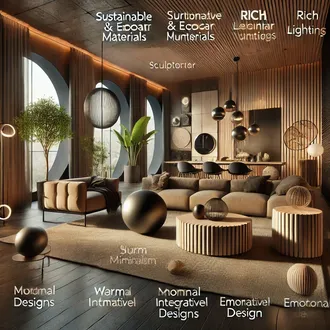Transcription Natural lighting
The lighting of interior spaces depends on two main sources: natural lighting -which comes from the sun and is incorporated through windows, doors, glass walls, etc.- and artificial lighting provided by different electrical devices.
The decorator, in order to achieve a design that has a positive impact on the physical and mental health of the occupants of the interior spaces, must achieve adequate visual comfort, combining the two types of lighting and properly selecting the colors of large surfaces, to avoid the indiscriminate use of electric light.
Natural light
Natural lighting is an important element in the development of the decorative idea, since it is the first aspect to consider when planning the distribution of other decorative resources, for example: the location of the furniture, the painting of the large surfaces of the interior and the location of the artificial light sources.
Natural light, although it has the disadvantage of being very changeable, has the following qualities that make it a very appreciated source of light in interior spaces:
- For a good part of the day it can provide higher levels of illumination than artificial light.
- It is very beneficial to health since it contributes to the control of numerous physiological and psychological processes; such as sleep stimulation, improved mood and activity levels.
- It can represent significant savings of electrical energy, which contributes to the protection of the environment.
Sources of natural light
- Direct sunlight: This is light that comes directly from the sun; it enters through an opening and falls directly on a part of the interior space. It is characterized by highlighting the bright and warm colors of the interior; it is distributed very irregularly in the space and deteriorates the objects on which it directly strikes -furniture, appliances, etc.-. Generally this component affects the interior spaces during a short period of the day, and it is very variable during the different seasons of the year, due to the interference of clouds, rain or fog.
- Indirect sunlight: Sunlight that, after being reflected by one or more interior or exterior surfaces, illuminates an area of the interior space. Compared to direct sunlight, its intensity is usually lower, it is more evenly distributed and causes less glare.
- Diffuse natural light: This is the light coming from the celestial vault. It is characterized by diffusing almost homogeneously in the space; it does not produce glare and highlights the cold colors of the interior space.
How to improve the use of natural light in interior spaces?
- By painting the large interior surfaces (ceilings and main walls) with brighter colors. Light surfaces allow a more homogeneous distribution of light in space and reduce the contrast between exterior and interior brightness, benefiting visual comfort.
- Surfaces facing natural light inlets (windows, glass walls, etc.) should be the brightest, so that they reflect light better.
- Do not place too much furniture in the rooms, select only the necessary ones and place them in such a way that they do not interfere with the passage of light.
- Place mirrors in such a way that they adequately reflect the light.
How to protect interior spaces from intense natural light?
Although natural light brings many benefits to the interior spaces, it can be uncomfortable for the vision and favor the increase of the temperature of the rooms -especially in the summer season-, so it is convenient to use some strategies to prevent or reduce the passage of light or the sun's rays.
- When the discomfort is caused by diffuse natural light, light curtains or other translucent elements can be used to reduce possible glare without blocking the passage of light into the interior.
- However, if the inconveniences are the result of the incidence of direct or indirect sunlight, opaque sunscreens should be used - curtains of thick fabrics, Venetian blinds, blinds, vertical curtains, etc. - because if thin curtains or other translucent elements are used, the sun's rays can cause very annoying glare.
natural light




